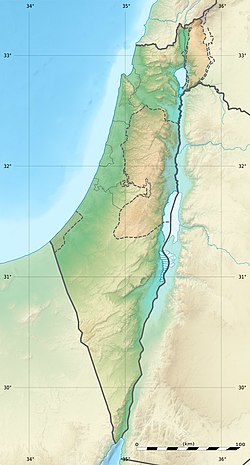 Tel Yarmuth (Khŭrbet el-Yarmûk) | |
| Alternative name | Tel Yarmouth |
|---|---|
| Location | Israel |
| Coordinates | 31°42′36″N34°58′48″E / 31.71000°N 34.98000°E |
| Grid position | 147/124 PAL |
| Type | settlement |
| Area | 18 ha |
| History | |
| Founded | circa 3000 BC |
| Abandoned | 3rd millennium BC |
| Periods | Bronze Age |
| Cultures | Early Dynastic Period |
| Site notes | |
| Excavation dates | 1970. 1990-present |
| Archaeologists | Amnon Ben-Tor (1970), Pierre de Miroschedji (1980), Paz Yitzhak (2014), Mizrahi Sivan (2014), Adawi Zubair (2014), Haber Michal (2014), Radshkovsky Igal (2014), Zilberbod Irina (2014), Greenvald Roie (2014), Sapir Neria (2014), Yoav Tsur (2014), Eirikh-Rose Anna (2014) |
| Condition | Ruined |
| Ownership | Public |
| Public access | Yes |
Tel Yarmuth (also Tel Yarmouth and Tel Yarmut; Hebrew name) or Khirbet Yarmuk (Arabic name) is an ancient Near East archaeological site in Israel located 25 kilometers southwest of Jerusalem and near modern Beit Shemesh. It is a large primarily single-period (EB II/III) site and has been suggested as possibly being the city of Jarmuth, being only a tentative identification, as it is based solely on the similarity of the Hebrew name with the Arabic name and its areal location. [1] [2]


















